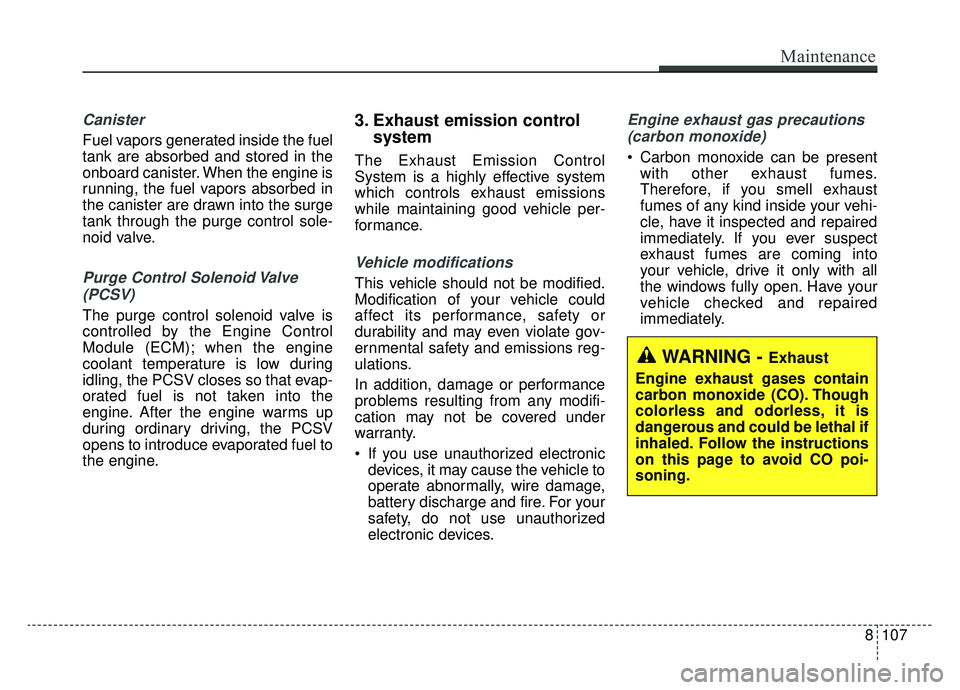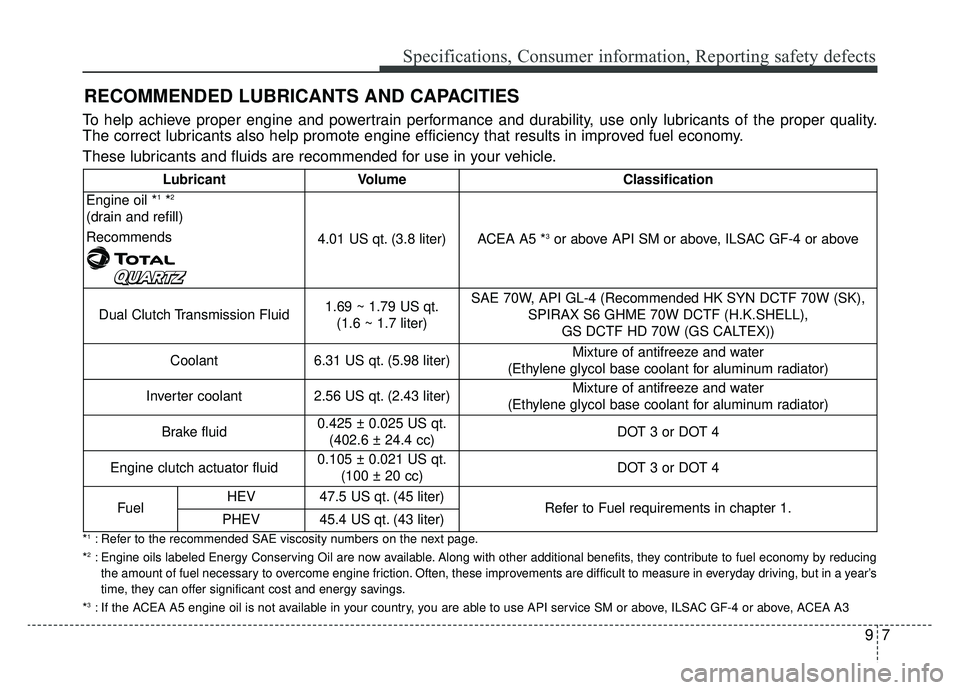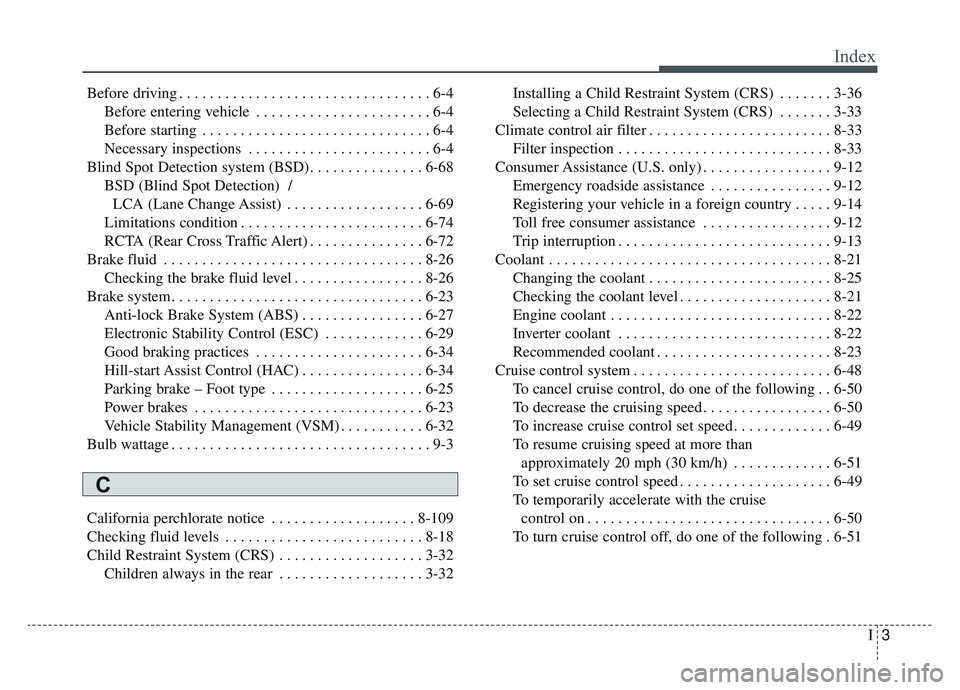Page 498 of 611
Maintenance
24
8
✽ ✽
NOTICE
Make sure the coolant cap is proper-
ly closed after refill of coolant.
Otherwise the engine could be over-
heated while driving.
1. Check if the radiator cap label is
straight In front.WARNING
Radiator cap
Do not remove the radiator cap
when the engine and radiator
are hot. Scalding hot coolant
and steam may blow out under
pressure which may result in
serious injury.
■Inverter coolant reservoir cap (Hybrid)
■Engine coolant reservoir cap
ODE076004■Inverter coolant reservoir cap (Plug-in Hybrid)
ODEP077004
ODE076006
OQL075072
■ Engine room front view
Page 499 of 611
825
Maintenance
2. Make sure that the tiny protru-sions inside the coolant cap
should be securely interlocked.
Changing the coolant
Have the coolant changed by an
authorized Kia dealer according to
the Maintenance Schedule at the
beginning of this chapter.
CAUTION
Put a thick cloth or fabric
around the radiator cap beforerefilling the coolant in order toprevent the coolant from over-flowing into engine parts suchas the generator.
ODE076007
■ Engine room rear view
Page 581 of 611

Canister
Fuel vapors generated inside the fuel
tank are absorbed and stored in the
onboard canister. When the engine is
running, the fuel vapors absorbed in
the canister are drawn into the surge
tank through the purge control sole-
noid valve.
Purge Control Solenoid Valve(PCSV)
The purge control solenoid valve is
controlled by the Engine Control
Module (ECM); when the engine
coolant temperature is low during
idling, the PCSV closes so that evap-
orated fuel is not taken into the
engine. After the engine warms up
during ordinary driving, the PCSV
opens to introduce evaporated fuel to
the engine.
3. Exhaust emission control system
The Exhaust Emission Control
System is a highly effective system
which controls exhaust emissions
while maintaining good vehicle per-
formance.
Vehicle modifications
This vehicle should not be modified.
Modification of your vehicle could
affect its performance, safety or
durability and may even violate gov-
ernmental safety and emissions reg-
ulations.
In addition, damage or performance
problems resulting from any modifi-
cation may not be covered under
warranty.
If you use unauthorized electronic
devices, it may cause the vehicle to
operate abnormally, wire damage,
battery discharge and fire. For your
safety, do not use unauthorized
electronic devices.
Engine exhaust gas precautions
(carbon monoxide)
Carbon monoxide can be present with other exhaust fumes.
Therefore, if you smell exhaust
fumes of any kind inside your vehi-
cle, have it inspected and repaired
immediately. If you ever suspect
exhaust fumes are coming into
your vehicle, drive it only with all
the windows fully open. Have your
vehicle checked and repaired
immediately.
WARNING - Exhaust
Engine exhaust gases contain
carbon monoxide (CO). Though
colorless and odorless, it is
dangerous and could be lethal if
inhaled. Follow the instructions
on this page to avoid CO poi-
soning.
Maintenance
107
8
Page 590 of 611

97
Specifications, Consumer information, Reporting safety defects
RECOMMENDED LUBRICANTS AND CAPACITIES
To help achieve proper engine and powertrain performance and durability, use only lubricants of the proper quality.
The correct lubricants also help promote engine efficiency that results in improved fuel economy.
These lubricants and fluids are recommended for use in your vehicle.
*1: Refer to the recommended SAE viscosity numbers on the next page.
*2: Engine oils labeled Energy Conserving Oil are now available. Along with other additional benefits, they contribute to fuel economy by reducing the amount of fuel necessary to overcome engine friction. Often, these improvements are difficult to measure in everyday driving, but in a year’s
time, they can offer significant cost and energy savings.
*
3: If the ACEA A5 engine oil is not available in your country, you are able to use API service SM or above, ILSAC GF-4 or above, ACEA A3
Lubricant VolumeClassification
Engine oil *1*2
(drain and refill)
Recommends
4.01 US qt. (3.8 liter)ACEA A5 *3or above API SM or above, ILSAC GF-4 or above
Dual Clutch Transmission Fluid1.69 ~ 1.79 US qt. (1.6 ~ 1.7 liter)SAE 70W, API GL-4 (Recommended HK SYN DCTF 70W (SK), SPIRAX S6 GHME 70W DCTF (H.K.SHELL), GS DCTF HD 70W (GS CALTEX))
Coolant6.31 US qt. (5.98 liter)Mixture of antifreeze and water
(Ethylene glycol base coolant for aluminum radiator)
Inverter coolant2.56 US qt. (2.43 liter)Mixture of antifreeze and water
(Ethylene glycol base coolant for aluminum radiator)
Brake fluid0.425 ± 0.025 US qt. (402.6 ± 24.4 cc)DOT 3 or DOT 4
Engine clutch actuator fluid0.105 ± 0.021 US qt. (100 ± 20 cc)DOT 3 or DOT 4
FuelHEV47.5 US qt. (45 liter)Refer to Fuel requirements in chapter 1.PHEV45.4 US qt. (43 liter)
Page 602 of 611

I3
Index
Before driving . . . . . . . . . . . . . . . . . . . . . . . . . . . . . . . . . 6-4Before entering vehicle . . . . . . . . . . . . . . . . . . . . . . . 6-4
Before starting . . . . . . . . . . . . . . . . . . . . . . . . . . . . . . 6-4
Necessary inspections . . . . . . . . . . . . . . . . . . . . . . . . 6-4
Blind Spot Detection system (BSD). . . . . . . . . . . . . . . 6-68 BSD (Blind Spot Detection) /LCA (Lane Change Assist) . . . . . . . . . . . . . . . . . . 6-69
Limitations condition . . . . . . . . . . . . . . . . . . . . . . . . 6-74
RCTA (Rear Cross Traffic Alert) . . . . . . . . . . . . . . . 6-72
Brake fluid . . . . . . . . . . . . . . . . . . . . . . . . . . . . . . . . . . 8-26\
Checking the brake fluid level . . . . . . . . . . . . . . . . . 8-26
Brake system. . . . . . . . . . . . . . . . . . . . . . . . . . . . . . . . . 6-23 Anti-lock Brake System (ABS) . . . . . . . . . . . . . . . . 6-27
Electronic Stability Control (ESC) . . . . . . . . . . . . . 6-29
Good braking practices . . . . . . . . . . . . . . . . . . . . . . 6-34
Hill-start Assist Control (HAC) . . . . . . . . . . . . . . . . 6-34
Parking brake – Foot type . . . . . . . . . . . . . . . . . . . . 6-25
Power brakes . . . . . . . . . . . . . . . . . . . . . . . . . . . . . . 6-23
Vehicle Stability Management (VSM) . . . . . . . . . . . 6-32
Bulb wattage . . . . . . . . . . . . . . . . . . . . . . . . . . . . . . . . . . 9-3
California perchlorate notice . . . . . . . . . . . . . . . . . . . 8-109
Checking fluid levels . . . . . . . . . . . . . . . . . . . . . . . . . . 8-18
Child Restraint System (CRS) . . . . . . . . . . . . . . . . . . . 3-32 Children always in the rear . . . . . . . . . . . . . . . . . . . 3-32 Installing a Child Restraint System (CRS) . . . . . . . 3-36
Selecting a Child Restraint System (CRS) . . . . . . . 3-33
Climate control air filter . . . . . . . . . . . . . . . . . . . . . . . . 8-33 Filter inspection . . . . . . . . . . . . . . . . . . . . . . . . . . . . 8-33
Consumer Assistance (U.S. only) . . . . . . . . . . . . . . . . . 9-12 Emergency roadside assistance . . . . . . . . . . . . . . . . 9-12
Registering your vehicle in a foreign country . . . . . 9-14
Toll free consumer assistance . . . . . . . . . . . . . . . . . 9-12
Trip interruption . . . . . . . . . . . . . . . . . . . . . . . . . . . . 9-13
Coolant . . . . . . . . . . . . . . . . . . . . . . . . . . . . . . . . . . . . \
. 8-21 Changing the coolant . . . . . . . . . . . . . . . . . . . . . . . . 8-25
Checking the coolant level . . . . . . . . . . . . . . . . . . . . 8-21
Engine coolant . . . . . . . . . . . . . . . . . . . . . . . . . . . . . 8-22
Inverter coolant . . . . . . . . . . . . . . . . . . . . . . . . . . . . 8-22
Recommended coolant . . . . . . . . . . . . . . . . . . . . . . . 8-23
Cruise control system . . . . . . . . . . . . . . . . . . . . . . . . . . 6-48 To cancel cruise control, do one of the following . . 6-50
To decrease the cruising speed . . . . . . . . . . . . . . . . . 6-50
To increase cruise control set speed . . . . . . . . . . . . . 6-49
To resume cruising speed at more thanapproximately 20 mph (30 km/h) . . . . . . . . . . . . . 6-51
To set cruise control speed . . . . . . . . . . . . . . . . . . . . 6-49
To temporarily accelerate with the cruise control on . . . . . . . . . . . . . . . . . . . . . . . . . . . . . . . . 6-50
To turn cruise control off, do one of the following . 6-51
C